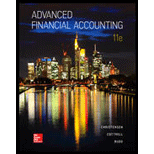
Concept explainers
a.
Concept introduction:
Consolidation entry: The basic consolidation entry removes the investment in parent company stock account and subsidiary’s
Which of the given companies G or R is parent company.
b.
Concept introduction:
Consolidation entry: The basic consolidation entry removes the investment in parent company stock account and subsidiary’s stockholders equity accounts. Consolidation is the process of combining the financials of subsidiary with financials of parent company. This is typically done when parent holds more than 50 percent of shares of another entity.
Percentage of owner ship parent R holds in subsidiary G
c.
Concept introduction:
Consolidation entry: The basic consolidation entry removes the investment in parent company stock account and subsidiary’s stockholders equity accounts. Consolidation is the process of combining the financials of subsidiary with financials of parent company. This is typically done when parent holds more than 50 percent of shares of another entity.
Amount to be reported without consolidating entry when net income for 20X7 is $70,000.
d.
Concept introduction:
Consolidation entry: The basic consolidation entry removes the investment in parent company stock account and subsidiary’s stockholders equity accounts. Consolidation is the process of combining the financials of subsidiary with financials of parent company. This is typically done when parent holds more than 50 percent of shares of another entity.
Increase or decrease in income to the non-controlling interest reported in 20X7 as a result of preceding consolidating entry
e.
Concept introduction:
Consolidation entry: The basic consolidation entry removes the investment in parent company stock account and subsidiary’s stockholders equity accounts. Consolidation is the process of combining the financials of subsidiary with financials of parent company. This is typically done when parent holds more than 50 percent of shares of another entity.
Preparation of elimination entry for consolidation worksheet on December 31 20X8.
Want to see the full answer?
Check out a sample textbook solution
Chapter 8 Solutions
Advanced Financial Accounting
- Financial Accountingarrow_forwardTwo investors are evaluating Anywhere e-SIM Ltd.’s stock for possiblepurchase. They agree on the expected value of D1 and also on theexpected future dividend growth rate. Further, they agree on theriskiness of the stock. However, one investor normally holds stocksfor 2 years, while the other normally holds stocks for 10 years.Is it true that they should both be willing to pay the same price forthis stock? Explain based on how stocks are valued and provide anumerical example to support your arguments.arrow_forwardPlease need answer the accounting questionarrow_forward
 Financial AccountingAccountingISBN:9781305088436Author:Carl Warren, Jim Reeve, Jonathan DuchacPublisher:Cengage Learning
Financial AccountingAccountingISBN:9781305088436Author:Carl Warren, Jim Reeve, Jonathan DuchacPublisher:Cengage Learning
